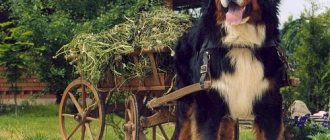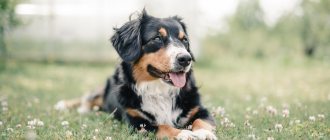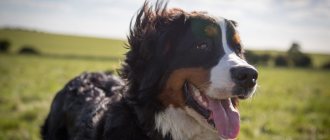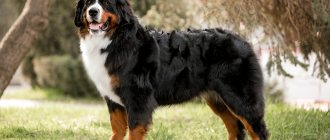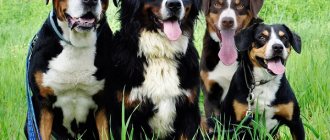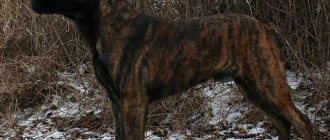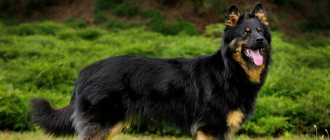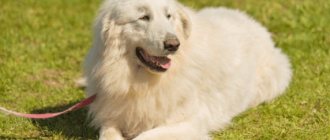Bernese Mountain Dogs are large, friendly and intelligent dogs. They can be the perfect companion for a person of any age. They belong to the herding breeds that have retained their working qualities. This huge dog has a peaceful, calm character. Its remarkable appearance immediately catches your eye: its features include its characteristic color, thick long coat and a good-natured smile on its face. Before getting a Bernese Mountain Dog, it is recommended to study the description of the breed and the features of its maintenance. It is useful to read reviews from owners, from which you can learn about the pros and cons of these dogs.
- Head
- Training and education of the Bernese Mountain Dog
- Nutrition
Breed traits
Breed traits (on a 5-point scale)
| Bernese Mountain Dog (Bernese Mountain Cattle Dog) | |||
| Activity | in the house | 1.9 | |
| on the street | 2.6 | ||
| Obedience | training | 3.3 | |
| strangers | 3.5 | ||
| Domination | in family | 1.9 | |
| over dogs | 1.8 | ||
| Defending your territory | from people | 2.1 | |
| from dogs | 2 | ||
| Sociability | in family | 4.8 | |
| with strangers | 3.8 | ||
| with dogs | 3.5 | ||
| Concentration | in family | 1 | |
| in front of strangers | 2.1 | ||
| with dogs | 1.9 | ||
| Aggressiveness | in family | 1 | |
| to strangers | 1.5 | ||
| to the dogs | 1.8 | ||
| to cats | 1.5 | ||
| Family behavior | calmness | 4.1 | |
| demand for affection | 4.8 | ||
| excitability | 3.1 | ||
| playfulness | 3.5 | ||
| excessive barking | 1.6 | ||
| behavioral breakdowns | 2 | ||
| Tolerance for children | up to 4 years | 3.9 | |
| over 4 years old | 4.5 | ||
| Institutional use | watchman | 3.9 | |
| bodyguard | 1.5 | ||
This breed is often compared to the following dog breeds: German Shepherd, Golden Retriever, Australian Shepherd, Newfoundland, Labrador Retriever.
The photo shows what Bernese Mountain Dogs look like:
Flaws
The lifespan of the Greater Swiss Mountain Dog is on average 8 to 11 years. The early death of a pet can be very upsetting for the owner's family, especially children. Sennenhunds are very attached to their owner and will worry if he is constantly at work.
The dog is very active, so daily exercise is required. The Sennenhund is ready to walk in the rain, in the summer heat, and in severe frosts. The future owner should know about this. Mountain Dogs can also be very stubborn. The owner will have to learn to negotiate with his pet on fundamental issues. The Greater Swiss Mountain Dog also needs daily brushing, otherwise his hair will be everywhere.
General characteristics of the Bernese Mountain Dog breed
Bernese Mountain Dogs are also called Bernese Shepherds or Bernese Cattle Dogs, or Bernese for short. This ancient breed, known since the 1st century AD. e., at first it was called Dürbechler, from the city of Dürbach, where it was especially widespread. The word zennenhund is translated from German as “herding dog.”
Now the breed is popular not only in its homeland because of the attractive appearance and amazing character of these dogs. They are used in search and rescue services, the police, and can transport cargo. The Bernese Mountain Dog is an excellent companion for families with children, patient, calm and obedient.
| Options | Characteristic |
| Name | Bernese Mountain Dog (German: Berner Sennenhund) |
| a country | Switzerland |
| group of breeds according to the ICF classification | Pinschers and Schnauzers, Molossians, Swiss Mountain and Cattle Dogs |
| application | shepherd, rescuer, companion |
| character traits | cheerfulness, sociability, curiosity, vigilance |
| life expectancy | 8-10 years |
| height | male 64-70 cm, female 58-66 cm |
| weight | male 39-50 kg, female 36-48 kg |
| activity | low, but requires long walking |
| attitude towards a person | friendly, loyal, does not tolerate loneliness well |
| intelligence | very smart, easy to train |
| difficulty of care | Difficult coat care, sheds heavily |
| health | average |
pros
Despite their enormous size, Bernese Mountain Dogs are unpretentious. They can live in a city apartment. The main thing is to communicate more with your pet, exercise with it and not put it on a chain. Then he will respond with devotion and obedience. The breed is suitable for families with children and inexperienced dog breeders. These dogs have several more advantages:
- attractive appearance;
- good health;
- high intelligence and good memory;
- balanced, flexible character;
- easy to train, try to please the owner;
- devoted, faithful;
- good-natured, completely devoid of aggression;
- live quietly next to other pets;
- not conflicting, not prone to dominance;
- not slobbery, clean;
- They love children, are patient with them, and can be a nanny.
Minuses
Representatives of this breed require long walks and a lot of attention. Therefore, lazy people, homebodies or those who are rarely at home should not get a Bernese Mountain Dog. These dogs need the constant presence of the owner, do not tolerate loneliness well, and a change of owner is a tragedy for them. They have a few other disadvantages that may cause problems for some people:
- Due to its large size, it is difficult to keep a dog in a small apartment - it will hit furniture, wag its tail, and drop objects;
- thick wool requires regular grooming and can emit a specific odor;
- these dogs mature slowly;
- can be stubborn and lazy;
- have a short life expectancy.
The video complements the characteristics of this breed:
Video: Bernese Mountain Dog - All about the dog breed
Video: Bernese Mountain Dog: features of keeping, character, education, pros and cons of the breed
Video: Bernese Mountain Dog: a shepherd dog with a good-natured smile
Advantages
The Greater Swiss Mountain Dog has a lot of advantages. He is intelligent, easy to train and very loyal to his owner. The Sennenhund is beautiful, so its owner will always notice admiring glances directed at the pet. The dog has a balanced character and will never bother you with barking. Some dogs start howling when left alone. This is definitely not about the Sennenhund. He loves his owner very much, but he will not howl in vain.
Sennenhunds are very hardy and playful. They will happily take the owners' child on a sled in winter. Dogs are very good-natured, so you can invite guests to your home without fear. If the Mountain Dog understands that people treat their owner kindly, he will treat them the same way.
The dog can be trained for protective guard duty. In this case, the Mountain Dog will become an excellent bodyguard. Also, a smart dog can be entrusted with guard duty at the site.
Origin story
The ancestors of the Bernese Mountain Dog are Molosser dogs that came to Switzerland with Roman legionnaires. These are large universal working dogs that helped warriors and could be shepherds and watchmen. They were distinguished by their endurance and calm, good-natured disposition.
The efficiency and obedience of these dogs were immediately appreciated by local peasants. They began to be used for grazing and guarding livestock, and transporting goods. They got along well in the mountainous areas, withstood the harsh climate and obediently performed any work.
But for a long time they did not arouse interest among breeders. Only at the end of the 19th century, the amateur dog breeder F. Shertenleib paid attention to them and began breeding them in a kennel. At the beginning of the 20th century they were called Bernese Mountain Dogs, and a breed standard was created at the same time. But until the middle of the 20th century, this breed was not popular and was not officially recognized, although it participated in exhibitions.
The Bernese Mountain Dog is one of the varieties of Swiss Mountain Shepherds, which also includes:
- large Swiss dogs;
- Appenzeller - shorter than Bern, tail curled into a ring;
- Entlebuchen are small dogs.
In the 40s, these dogs began to be crossed with Newfoundlands. Thanks to this, the appearance and quality of the coat improved, and the dogs began to love swimming. The black color in the color has become brighter, and the character has become calmer. By the end of the 20th century, Bernese Mountain Dogs became one of the most popular dog breeds in the world.
Breeding
What are some recommendations for breeding Greater Swiss Mountain Dogs? In dogs, the first heat most often occurs around the age of one year. The next one normally comes in 5-10 months. If the bitch is already 2 years old and has not been in heat, this is a reason to be examined by a veterinarian. Usually the issue is a hormonal imbalance or underdevelopment of the genital organs.
Males and females of the Greater Swiss Mountain Dog breed are recommended to be bred at over 18 months of age. In order for a litter to be officially registered, dogs must receive breeding assessments. Before mating, the owners sign a document, which is subsequently handed over to the club by the owner of the bitch.
If a dog is in heat and its owners dream of puppies, then they must calculate the optimal period to meet a male dog. If this day is incorrectly determined, the bitch will remain empty. There are several methods, but the most popular among breeders is taking blood to check progesterone levels. This method is the most accurate. You can also examine vaginal smears, but this method is less informative.
If the bitch is ovulating soon, you can go to the male. For inexperienced dogs, it is advisable to invite a mating instructor. He will help the animals if things don’t work out. After successful mating, a control test is carried out after 2-3 days.
Appearance Standards
Bernese Shepherds are large dogs with thick, long hair. They look very beautiful, with a harmoniously built body and a spectacular tri-color color. A characteristic feature of its appearance is its smiling face. The Bernese Mountain Dog is above average in height. Males can grow up to 70 cm, with an average height of 66-68 cm. Females are smaller, their size can be 58-66 cm. Bernese Mountain Dogs gain weight and grow actively until the age of two. Adult dogs weigh on average 36-50 kg.
Head
The head is large, but proportional to the body. The skull is wide, with strong bones. The forehead is rounded, the brow ridges and feet stand out well. The muzzle is wide, elongated, wedge-shaped. Length equal to the length of the skull. The bridge of the nose is straight, the lobe is large, and must be black.
The cheekbones are well defined, the lips are thick, but fit tightly and do not form jowls. The mouth is deep; when relaxed, the muscles form a smile characteristic of the breed. The teeth are large, even, scissor bite.
The Bernese Mountain Dog's eyes are small, almond-shaped, and dark in color. The eyelids are close fitting, not everted, and black. The ears are medium in size and set high. They are triangular in shape with rounded ends, hanging.
Frame
The body is rectangular in format, muscular. The neck is of medium thickness, blends smoothly into the withers, the scruff is well defined. The back is straight, wide, the loin is slightly convex and narrowed. The croup is not sloping. The chest is round, deep, the stomach is tucked.
The tail is saber-shaped, thick at the base, tapering to the tip. When the dog is calm, hangs down, reaching the hocks. When excited it rises to the level of the back. Should not be twisted into a ring.
Limbs
The forelimbs are straight, thick, set parallel and wide. The shoulder blades are oblique, elongated, the elbows are directed back and pressed to the chest. The hind limbs are also parallel, with pronounced muscles. The thighs are long and muscular. The angles of the joints are sharply expressed. The paws are round and large. The Bernese Mountain Dog runs at a trot, movements are free.
Coat and color
The coat is double and thick. The guard hair is long, shiny, silky to the touch. Usually straight, but may be slightly wavy. It is shorter on the head and front of the legs. Long feathering on the ears, neck, back of the limbs, and tail. The undercoat is soft and dense, protecting the dog from any weather. There is no seasonal shedding, the coat changes little by little all the time.
The Bernese Mountain Dog can only have one color. The main color is black. There is bright red tan on the cheeks, chest, belly and limbs. Characteristic are the red markings above the eyes, for which in ancient times these dogs were considered sacred. Starting from the forehead, a white stripe runs along the nose and chest. There are also socks on the paws and a white tip on the tail. All colors should be bright, with clear boundaries.
Disqualifying faults
The breed standard defines exactly what the appearance should be. If there are any deviations, dogs are not allowed for exhibitions and breeding. There may be the following disadvantages:
- light frame;
- height below or above normal;
- too curly coat;
- very few or many white areas;
- asymmetrical arrangement of the tan;
- curled tail;
- everted eyelids;
- short hair.
Photos complement the description of the appearance:
Attention! Not for an apartment!
Hi all! After reading sweet reviews about this breed, I decided to give a puppy to my husband and now I really regret it.
We bought a house without interior decoration and, figuring that a couple of months would be enough for repairs, we decided to get a dog and live with him in an apartment while he’s small, and then we’ll move. The plan was great, but we didn’t take into account that the renovation was delayed indefinitely, and the baby is growing very quickly .So quickly that I didn’t even have time to take a photo of him while he was little. Now he’s 6 months old and I’m in a panic.
I’ll say right away that I’m writing all this so that when you look at my mistakes, you won’t make the same ones and ruin the life of yourself or your dog.
1. The puppy is wonderful in every sense, a very beautiful teddy bear, cheerful and calm, smart and delicate.
2.grows very quickly, even rapidly, take pictures while doing it)))
3, wool is everywhere, all over the house, in food, on all clothes and there is no escape from it, combing it out does not completely save it, but of course it reduces it. Moreover, our boy really doesn’t like to itch and you need to have good patience to completely comb him out. Over time, however, he is more calm about this procedure, but still not angelic.
4. We, as you understand, have a guy, and as a decent-sized guy, he requires a firm hand, which, unfortunately, we don’t have. This is probably my most bitter point. My husband treats him like a member of the family and indulges him in everyone instead of raising him.
5. Our baby loves to sleep next to his owner, which means next to the bed on my side, not only do I always bump into him when I get up, he stretches and scatters my slippers and I have to look for them under the bed or around, he’s terribly loud and breathes very intensely. Please don’t laugh, it’s not funny, I’m a doctor and I always listen to his breathing and it seems to me that he’s very ill. He’s probably hot, but he breathes like a marathon runner after a run, and water is always within reach. I often wake him up husband and say, do something, he’s hot. But what will he do, we live in a small apartment now, all the windows and the balcony are open. I’m trying to take him to the balcony, it’s cooler there at night, but he doesn’t want to, you know, he’s used to it . to always be nearby and perceives the balcony as a place of punishment or something. In general, I can’t sleep peacefully, especially since he also farts often. We already know which food makes him fart more often, which food makes him fart less often, considering that his weight is already 37 kg, this fart is something.
large gas burner for roofing
6. at home he’s frankly bored, he wanders from place to place, lies here and there, but when we arrive at our house, it’s a completely different dog, joyful, happy, runs around with sticks, chews on pine cones and I see a completely smiling dog .He feels good there, it’s spacious, it’s fresh, there I see his shepherd’s character, if we start to wander off, he first finds a strategic point from where he can see everyone and just turns his head watching us, when we disappear from his sight, he runs between calmly and as if unnoticed, he will run up, wave his tail, sit for a while and then run on.
7. even if a miracle happens and in a month or two we still finish the house and move into it, I can’t imagine how to accustom him to an enclosure, it will not be stressful for him, but more stressful, all breeders talk about this, it is necessary to accustom him to a puppy , it’s too late now. Of course, we were in a hurry to purchase it, that’s why I’m writing, maybe someone is thinking about what breed to get. When we were at the exhibition, our baby, by the way, received a certificate as very promising, I talked with different breeders and it turns out, almost All. They live in their own house and keep dogs in enclosures. Even the participants’ brochure has an address; almost all of them have private houses.
8. gnawed a pair of my slippers, the rest of the family don’t wear slippers, calmly eats everything on the table that’s there, peed on our bed and the children’s bed several times.
Source
Personality of the Bernese Mountain Dog breed
Bernese Mountain Dogs are large, outwardly formidable, but good-natured and affectionate dogs. They are sociable, sociable, and peaceful. They are wary of strangers at first and are ready to protect the owner and his family members. But if the owner is calm, the dog will also be friendly and try to get to know each other.
These dogs are not prone to display nervousness, aggression or cowardice. Even with unfamiliar dogs on the street, they never come into conflict. But they have a developed instinct to protect their territory and family members. Although the dog scares away intruders rather with its impressive appearance.
The Bernese Mountain Dog needs to be close to a person at all times. He usually chooses one owner, becomes strongly attached to him, and remains faithful to him. But he treats all family members equally kindly and listens to them. This is a herding dog, it likes to have all its loved ones together and gets nervous when someone is missing.
The Bernese Mountain Dog gladly accompanies its owner, participates in all his affairs and obeys unquestioningly. He is ready to carry out any instructions, just to receive praise and affection. She enjoys carrying purchases from the store and pushing her children around in a cart.
This dog is very sensitive, understands the intonation of the voice. He must feel needed, otherwise he may become depressed. Young dogs are more active. They are inquisitive, playful, and can fool around and play pranks. An adult dog is calm and phlegmatic, loves to lie on the sofa. The main thing is that the owner is nearby.
The Bernese Mountain Dog is very patient with children and calmly tolerates any mischief. Treats kids leniently and never bites. Happy to support different games. He is aware of his superior size, so he behaves carefully when interacting with children. Only at a young age, due to inexperience, can one accidentally push the baby. An adult dog will protect and protect the child, take care of his safety.
These dogs can be described as follows:
- inquisitive;
- good-natured;
- devotees;
- sociable;
- cheerful;
- reasonable;
- calm;
- devotees;
- vigilant;
- stubborn.
Photos illustrate the behavioral features of these dogs:
Training and education of the Bernese Mountain Dog
The Bernese Mountain Dog needs to be trained from the first days the puppy arrives in the house. This is an intelligent dog, but lazy and stubborn. Therefore, training must be consistent and regular. You immediately need to teach not to jump on people, not to grab their legs, not to bark for no reason, not to climb into the bed. Since this dog is friendly, it is also necessary to wean him from taking food from the hands of strangers.
The puppy needs to be accustomed to its place, name, and collar. The first commands that he should understand already at 4-5 months:
- to me;
- sit;
- it is forbidden;
- near;
- stand;
- ugh;
- lie.
Training should be short and varied. Puppies get tired quickly and get distracted. It is necessary to interest them, so it is recommended to build classes in the form of a game. They should bring joy to the dog, then he will be happy to learn new commands. It is important to remember that you cannot scold, much less beat, a Bern. They are very sensitive, so the main place in education should be not punishment, but encouragement.
It is necessary to take into account the temperamental characteristics of this dog. She is smart, quick-witted, but does not react with lightning speed to commands, like some other shepherd dogs. This is due to the natural slowness and laziness of the breed. In addition, they are reasonable and will not mindlessly follow all orders.
Another feature of Bern breeding is that they mature slowly. Until 2-2.5 years old, you need to pay a lot of attention to the dog, exercise it daily, and socialize it. More serious training can be started under the guidance of a dog handler after the age of 2 years. These dogs can be taught to carry loads and be a guide. Despite its developed protective instincts, you should not train this dog for protection. She has no aggression, she cannot bite a person
Feeding
The Greater Swiss Mountain Dog's diet must be balanced. If the owner is not familiar with veterinary nutrition, then it is better for him to stop at industrial food. A balanced diet is especially important during the puppy’s growth period. If you feed your baby incorrectly, the consequences can be disastrous.
The Greater Swiss Mountain Dog is a large dog, so puppies may experience bone and joint problems due to their rapid growth. In ready-made industrial diets, everything is already balanced, so most often such difficulties can be avoided. If the owners want to feed the baby natural food, then they must understand that the puppy needs to be given additional vitamins. It will be better if the mineral preparation is selected by a veterinarian.
Owners should not skimp on their puppy's diet, as low-quality ingredients can cause the baby to get sick. As for meat, it is better to give preference to beef, turkey, and rabbit fillet. It is permissible to introduce lean lamb into the diet. Chicken is given to the Mountain Dog only if he is not allergic to it. But you can’t feed your dog meat alone. Owners are advised to introduce vegetables and dairy products into his diet.
Features of keeping the Bernese Mountain Dog
Thanks to its unpretentiousness and calm temperament, you can keep the Bernese Mountain Dog in an apartment. But he will feel better in a large private house with a plot. Although this is more of a domestic dog, it should not be chained or left in an enclosure for long periods of time. Without communication with a person, she will get bored.
The Bernese Mountain Dog is not a toy dog. Although representatives of the breed are quite lazy and slow, they require physical activity and daily walking for at least two hours a day. During walks, these dogs love to play and take children on sledding rides, but they are not capable of long runs. If the street is dirty, it is recommended to take your Berna out for a walk in waterproof overalls, as the fur gets very dirty, and when it gets wet, it smells unpleasant.
Bathing this dog is often not recommended. The Bernese's coat is thick and dries slowly. Eczema and inflammation can form under it. Therefore, bathe your pet no more than once every 1-2 months. But after each walk, you need to wash your paws, pick out debris and sand from the fur between your toes. For bathing, you need to choose a hypoallergenic shampoo for long-haired dogs. If possible, it is better to replace washing with swimming in ponds, and in winter - in the snow.
It can be difficult to care for the Bernese Mountain Dog's coat. It needs to be combed 2-3 times a week with a long-toothed comb. You will also need a slicker brush to work out the fuzz on the neck and legs. Otherwise, tangles will form. If this happens, it is better to try to untangle them. Trimming is not recommended, as this will worsen the condition of the coat. You can only shorten the fur between your fingers, which will make it easier to maintain cleanliness.
Other hygiene procedures are the same as for other pets:
- clean your ears with a special lotion once a week;
- regularly examine the eyes and remove discharge;
- Give chewable bones or brush teeth weekly with veterinary toothpaste;
- if the claws do not grind down on their own, trim them with a nail clipper;
- in the warm season, treat the wool every month for external parasites.
Nutrition
Bernese Mountain Dogs are prone to food allergies, so you need to choose their food carefully. Breeders usually recommend feeding the dog dry food. You need to choose brands with a high protein content, fat should not exceed 16%. Super premium or holistic food for large breeds is desirable. The composition should not contain corn, soy and wheat.
With natural feeding, the main part of the diet should be meat and offal. This is approximately 35 g per 1 kg of dog weight. Several times a week you can give boneless sea fish and egg yolk. It is useful to supplement protein foods with cereals, vegetables, and dairy products. With this method of nutrition, it is recommended to give vitamin supplements.
It is forbidden to give the dog fatty foods, legumes, baked goods, and sweets. You cannot feed sausage, semi-finished products, or food from your table.
A puppy up to one year old is fed 5-6 times a day, depending on age. An adult dog needs 2 meals a day. You need to feed after a walk so that the dog does not overexert itself on a full stomach - this can lead to bloating and even volvulus.
Also, representatives of the breed are prone to weight gain, so it is advisable not to overfeed and monitor the amount of food. The bowl must be placed on a stand at chest level. The dog should not bend over, this will help avoid diseases of the musculoskeletal system. Clean water must always be freely available.
Health
Like many other large dogs, Bernese Mountain Dogs are not long-lived. If you create suitable conditions for your pet and follow the rules of care, he will live 12-13 years. And for most individuals, life expectancy is 8-10 years.
Representatives of the breed often have the following diseases:
- joint dysplasia;
- eye diseases – retinal atrophy, cataracts;
- dermatitis;
- degenerative myelopathy;
- epilepsy;
- blood clotting disorder;
- oncological diseases.
Most of these pathologies are hereditary; a DNA test will help determine their presence. You can protect your dog from other diseases by properly caring for it and getting all the required vaccinations on time. To prevent obesity and joint pathologies, you need to monitor your pet’s diet and physical activity. Skin diseases can be avoided if you treat parasites promptly and do not allow your pet to overheat.
Video about the features of grooming:
Video: Bernese Mountain Dog/coat care, tick treatment
Diseases and health problems
The Bernese Mountain Dog cannot boast of good health. The average lifespan of these animals is 9-10 years, subject to good care, quality nutrition, and timely vaccination.
Quite often, Berns are diagnosed with volvulus. This pathology develops rapidly and it is impossible to save the animal without emergency surgery. Due to errors in nutrition, the dog experiences bloating, the stomach becomes full of air, and the intestines become twisted. In this case, the pet's breathing becomes uneven, and the temperature may rise.
Large individuals often develop dysplasia of the hip and elbow joints, arthritis, and osteochondrosis, which causes progressive lameness. The dog is constantly in pain. To exclude these pathologies, it is necessary to monitor the pet’s physical activity. You should not overload the dog’s joints by forcing him to perform a large number of jumps. The animal is gradually accustomed to working with weight.
Quite common is such an unpleasant phenomenon as entropion of the eyelids, when the eyelashes along the edges of the eyelid greatly irritate the dog’s eyeball. Some individuals develop cataracts after 5 years of age, and retinal atrophy progresses, which can lead to complete blindness.
Sennenhunds do not tolerate high temperatures and stuffiness, so they can easily get heatstroke when exposed to the scorching rays of the sun or a stuffy room. A number of pets experience problems such as severe hair loss, that is, alopecia and depigmentation of the nose. Most health problems are related to diet.
How to buy a Bernese Mountain Dog puppy
To buy a purebred puppy, it is better to contact a nursery. You can find out about conscientious breeders at dog shows or websites. In Moscow, the cost of such a dog is on average 50 thousand rubles. If the parents are champions, the price increases to 80-100 thousand rubles. It is better not to buy a puppy on the market or through an advertisement. Although it will cost less, it is possible to purchase a non-pedigreed dog or one with hereditary diseases.
Before choosing a puppy, you need to study the living conditions of the animals and get to know the mother. It is important to check the pedigree and all veterinary certificates. Pedigree puppies have a strong build and a tricolor color. They should be curious, not cowardly, and sociable.
It is better to immediately decide on the gender of the puppy. Males are stronger and more resilient. They look impressive and look better at exhibitions. But more often they are stubborn and can run away on the street after a bitch. Girls are more flexible and calm. They learn commands more easily.
The photo shows what the puppies look like:
The video complements the description of the breed:
Video: Bernese Mountain Dog - all about the breed. Interesting facts about the Bernese Mountain Dog
Video: Bernese Mountain Dog. Pros and cons, price, how to choose, facts, care, history
Video: Bernese Mountain Dog. Everything you wanted to know about this breed
Bernese Mountain Dogs are popular family dogs with amazing qualities. They are obedient and easy to train, even for an inexperienced owner. You just need to pay attention to the dog and love it. This dog is not suitable only as a guard, since it is completely devoid of aggression towards humans.
Price
Judging by reviews of Greater Swiss Mountain Dogs, it is better to buy a puppy between the ages of 1.5 and 8 months. At this age, babies get used to their owners more easily. But if you wish, you can also buy an adult dog. Sennenhunds are very friendly, and over time they will adapt to their new family.
The price of a puppy depends on many factors. For example, on the origin of the baby, the number of titles his parents have. Puppies with excellent exterior characteristics are always more expensive than simpler ones. In some cases, small Sennenhunds that are promising for exhibitions are sold only as co-ownership.
Now the price for pet class puppies starts from 20 thousand rubles. Such Sennenhunds are not suitable for participation in exhibitions, as they have deviations from the standard. But you can take part in sports competitions or shepherd competitions with them. Puppies that are promising for show cost an average of 35-60 thousand rubles.
Three interesting facts
- They fiercely and relentlessly protect the weak half of humanity . If the breeder turns out to be a woman, then men should be more careful when approaching a lady with such a dog on the street. Since ancient times, the Grosses have protected the family and especially its weaker members, women and children. This habit became firmly established and became a character trait.
- Can't stand perfume . Very often this breed is allergic to strong odors.
- They feel calm in harness . They can be harnessed together with ponies, for example. And all because for a long time grosses were used as draft animals.
